Wednesday, January 29, 2014
Mark and Gaz
As I wandered down the garden the weekend before last I caught glimpse of our Gunnera tinctoria that is sited on the raised bed adjacent to our bottom patio pond. It is dormant at the moment, currently hiding underneath last years growth with its own leaves snapped and folded on to itself to protect the main crown and the smaller bud surrounding it from the worst of the winter.
On some years we would throw in a few layers of fleece in between the crown and its own leaves just to give it some extra insulation. And sometimes we would even anchor down the folded leaves with netting fastened with tent pegs just in case the winds would uncover it especially as the leaves itself rot down through the course of the winter. This winter we haven't bothered with any of both and just relied on the leaves itself to rest on to the crown and do its thing. So far so good but then again it's been a mild winter so far.
 |
| Not a pretty sight but look at those buds! |
The main crown and the smaller buds have been steadily increasing in size over the past few weeks and will continue to do so until in spring when they open up and new leaves emerge that will just get bigger and bigger through the course of the growing season. We find that the first batch of leaves that they release tend to become the biggest ones that they'll ever produce in that growing season, with the ones following them only marginally smaller.
Looking at the Gunnera has also reminded me of one of the most common questions we get asked by visitors to the garden: Is it possible to grow a large Gunnera long term in a container?
Yes of course, this one has been container grown by us at least since 2007. I can't remember anymore when exactly did we buy it, perhaps just the year before that but it did live in the garden centre where we bought it from for several years before we actually bought it. As for long term, well that's relative but with the right care a giant Gunnera can thrive in a container for years.
There are two giant Gunneras that are readily available here, G. manicata (Brazilian) and G. tinctoria (Chilean). They both get very big but apparently the former gets a touch bigger than the latter. In reality size difference between the two seems negligible so whichever you choose the care and result you'll get will likely be the same.
This plant prefers a free root run of course and keeping it in a container will curb its growth and the size of the leaves they produce to varying degrees. The bigger the container, the better and leaves they can produce can be bigger too.
It likes a rich growing medium that is moisture retentive but not permanently waterlogged. Naturally it doesn't grow on ponds or bodies of fresh water that keeps it permanently submerged but rather on the banks wherein it can keep its 'feet' wet by being near the water whilst the rest of the plant well above it.
So when growing on a container make sure it still has some drainage whilst at the same time conducive to retaining extra moisture which it needs especially in the summer. The Gunnera has an extra high moisture requirement especially in the summer but will also detest being permanently waterlogged. Generous moisture in the summer months will encourage larger leaves and vigorous growth as well as keep their leaves upright even on the warmest parts of the day. Its leaves are prone to droop down when it gets really warm and moisture supply is low and potted specimens are more prone to this, less so for those on the ground.
When we first planted ours on a wooden container it was first lined with strong plastic (compost bags) that were pierced at random places. This made the container hold more moisture but at the same time still has means for drainage of excess of it. Same principle when we transferred it later on to the raised but this time using an old pond liner.
They tolerate dappled shade up to full sun as long as their moisture supply remains constantly high which keeps the leaves from drooping. The best site for it is semi/dappled shade.
How do we maintain ours? In the spring we clear off all the remaining old leaves and give it a dose of liquid fertiliser to give it an initial boost. We also push in on to the soil some plug fertiliser as this plant is a gross feeder and responds really well with extra feeding by putting on large growth. Then it is watered generously as and when needed. As it is on a raised bed with cobble mulch to prevent soil going on to the pond, it has little access to naturally rotting organic matter hence the need to give it summer supplements to support a good display.
So if you don't have the space to have one growing on the ground and getting to gigantic proportions, it is still possible to haveone but grown in a container. It may never get as big but it can still size up enough for an impressive summer show in the garden!
Mark :-)








































 This gardening blog follows our journey as we create our Tropical and Exotic themed garden. We hope you'll enjoy the journey as much as we do. We started our Exotic Garden in 2005 and this site will show its development, as well as our travels, both abroad and within the UK to gardens, nurseries and friends.
This gardening blog follows our journey as we create our Tropical and Exotic themed garden. We hope you'll enjoy the journey as much as we do. We started our Exotic Garden in 2005 and this site will show its development, as well as our travels, both abroad and within the UK to gardens, nurseries and friends.











